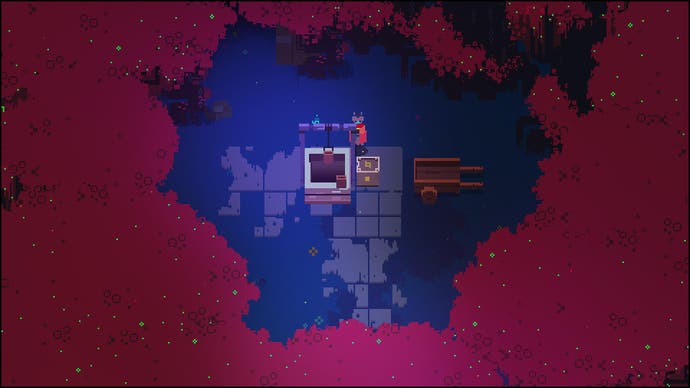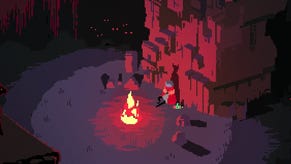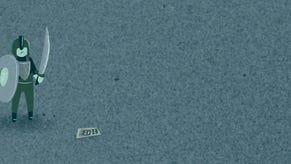Hyper Light Drifter review
Dashing through the glow.
Editor's note: Hyper Light Drifter comes to Xbox One and PS4 today, complete with the two-player co-op mode added since the game's release on PC. To mark the occasion we're republishing our original review, which first went live in May.
In a library at the top of the world, I found a few moments of peace. The journey up the mountain had been hard, past frosted willows and over ancient tumbledown staircases. Crows attacked - huge things in robes, capable of violent magic. Wolves sent deer scattering. And then I found my way here: to row after row of documents, scattered papers on the floor, shelves creaking and broken-backed. Sunlight angled in through shattered rafters. Silence except for a distant wind. I knew the nods towards secret areas by now, and I sounded them all out: health packs in a shuttered reading room where a skeleton sat at a desk, money out on a spar of rock overlooking an endless drop and a rosy horizon. Up ahead there was more of what I'd left behind. More encounters. More breathless dashing. And a boss was looming. But for now - only for a minute or two - it was me and the wind and the ancient bookshelves. A moment to simply enjoy the beauty of Hyper Light Drifter without the attendant carnage.
One of the strengths of this game is that it explains almost nothing. It hints at a basic narrative - you play a stranger in a ruined land, searching through the rubble of a long-gone civilisation for some kind of cure to a blight that has afflicted you - but it doesn't fill in the blanks particularly willingly. Its landscapes, filled with prison forests, mountainous archives and underground robot factories, all hint at rich depths, aeons in which nature and technology have twisted themselves together, and little of this is initially exposed to the player. In the first few minutes you have to learn to identify the health packs scattered about the place, and in the first few hours you have to learn how the game deals with the money you need for upgrades. The only thing Hyper Light Drifter is swift to make entirely clear, in fact, is that this is not the game that the dreamy, delicate art initially suggests. It is not a gentle Zelda dressed up in Topshop cyans and hot pinks, a place where dungeons succumb to quiet intellect as much as the sharp point of a sword. In fact, it is a relentless battle, grinding and exacting. It is a game about fighting, and an adventure that does not trade in joy so much as relief.

And at first it is overwhelming. Hyper Light Drifter's map is divided into four sections, with a small nub of upgrade shops in the very middle. Your job is to venture north, east, south and west and defeat the creatures living there - I hesitate to apply the word "evil", because, by the end of the game, I wasn't entirely sure that I was exactly on the side of the angels. There is some freedom to the order in which you take things on. Hyper Light Drifter is an intricate beast geographically, but it's best not to think of the game as being built around four dungeons. Each area, instead, tasks you with taking out a boss and tracking down four separate terminals, all of which lurk in their own mini-dungeons, often underground and tucked away from the overworld. Navigation is an early hurdle, since the maps on offer only really highlight the very basic area in which you are located: you then have to work out how the hubs fit together with the spokes. The upside of this is that I always felt pleasantly lost, and I had to make notes as I travelled so that I would know to return and clear up loose ends. I couldn't live within the map screen; I had to pay attention to the territory itself. The downside is that Hyper Light Drifter has a very instanced feel: its separate areas are connected, but they never feel like they seamlessly lock together in the manner of a Lordran or even a Hyrule.
Navigation is the least of your problems, anyway. Hyper Light Drifter is rather strange when it comes to combat, or rather it takes a few hours for its approach to click. The tools at your disposal are elegantly intertwined. Sword slashes charge up ammo slots for your firearms, of which you will eventually come to own a handful, covering everything from handguns and snipers to one of the best shotguns in recent years. There is also a dash that gets you out of trouble or allows you to cross gaps between ledges, but does not grant immunity. At an upgrade shop, you can deck it out to deflect incoming projectiles - and you can also flare it and all your weapons and moves in a few additional ways - and you can buy grenades to lob, although they come with a lengthy recharge. Recharge, hack and slash to enable overpowered firearms, dash out of danger to preserve a limited health bar: these elements suggest a game built around precision, and yet for a few hours the game seems to throw congregations of enemies at you in messy globs, ranged foes milling around with melee dealers, locked in tight spaces that seem to cripple any instincts towards theatrics.
You have to learn how to approach things, in other words, and a lot of what you're learning about is target prioritisation and movement over open spaces. One of Hyper Light Drifter's few acts of kindness is that it saves at the entrance to every room, and so you can experiment in each encounter a little, working out who to take down first, when to waste time on movement, and when to cash in a shotgun blast you've saved up. Beyond that, you learn that, Dark Souls-style, healing takes a few crucial seconds during which you're dangerously exposed. You learn that each swipe of a sword combo moves you forward a few steps. And once you know these things and how to work with them, the chaos of each room's battle seems to dissipate somewhat.

It would be easy to say that Hyper Light Drifter drops Zelda's puzzles in favour of combat, then, but the truth is that combat often is a puzzle. Enemy types are relatively limited, but over the course of the game you will learn that each requires its own approach. Robots that stagger up off the ground and like to head for you in packs are best dealt with in one blow from a close-up shotgun. Shuriken throwers are best taken out before tackling normal grunts, and come in groups of three, one of whom is often concealed. Wolves run for you and can be smacked away with the right timing; at least one of the birds is only targetable when it is ducking in for the kill.
Add bosses: four standards - all of which, I'll admit, brought proceedings to a juddering halt for me when first encountered - and a few more tacked on in the final act as a sort of mini-rush. Bosses require patience and attention to detail: you are asked to exploit tiny gaps in their patterns. But they are ultimately fair. Just really, really tough. The sense of elation when you get rid of one is a delight, and the game knows it: your enigmatic little hero suddenly flourishes and plonks his sword in the ground. Job done.
At times, it all sings. There are moments when you feel the designers really getting to grips with the restrictions that make Hyper Light Drifter work - moments where you slide between shifting patches of cover, ducking fire from slow-targeting turrets and picking off baddies in the optimal order. Equally, there are moments when the designers just don't know when to ease off. One section, involving - oh god - moving hammer blocks, a maze, darkness, dead ends and spiders, is a straight-up abuse. It's not fun, it carries you far from your last save, and it requires leaps of faith, some of which are punished by instant death.

Still, there is lots here, from fighting crystalline dogs in a scarlet forest to dashing from broken pillars in a peaceful flooded temple complex. There isn't much that happens to you in Hyper Light Drifter, in fact, that doesn't feel like it could have come from a King Crimson lyric, and this is all delivered through exquisite and evocative pixel art: a flexible style that can lend a brittle melancholy to a forest glade home to stray deer and an old factory filled with rusting conveyor belts and dismantled machinery - an art style that seems to see no distinction between the two, really, endowing both with an air of ancient mystery. Meanwhile, the Disasterpeace soundtrack is a typical delight, shapeshifting coherently between Vangelis and Badalamenti, and equally happy to devolve, at times, to a menacing server-room rumble.
The atmosphere these elements create is so intoxicating that you might end your first playthrough feeling ever so slightly shortchanged. Not by the challenge, for sure, or the precision, but by the fact that a world as beautifully detailed as this - a world where desks are piled with clutter and monoliths are scattered with ancient runes and terminal ports - is so unwilling to let you get in close. In the headlong pelt of my first campaign, the amazing environments started to feel like mere backdrops as I sized up targets and focused on getting the kill as economically as possible. That's it, really, in a nutshell: I didn't want to approach a world as seemingly rich as this with economy at the forefront of my mind.
I missed as much as I saw, however. That's my feeling as I now hover over the New Game Plus mode on the menu. So much loot I left behind, a few weapons I failed to track down, a few monoliths I couldn't activate, a sweep of doors whose incremental keys I never really started to collect. Out there, I suspect, is at least one more ending. And then there are the empty prompts: the areas whose purpose I couldn't fathom, the rooms I couldn't find an entry-point to.
I'm going to return to this landscape one day: punishing as it can be, Hyper Light Drifter is a delight far more often than a slog.










